Footnotes:
On 27-28 May, Guangdong "Three Division" Professional Volunteer Association invited representatives from the Education and Technology Department of the Hong Kong Liaison Office, the Hong Kong Institute of Architects and the Hong Kong Institute of Planners to visit and exchange ideas on the foundation of South China's education and history, to explore the humanistic inheritance of the same roots in Guangdong, Hong Kong and Macao, and to actively promote economic and cultural exchanges among the Guangdong, Hong Kong and Macao Bay Area.
As a matter of fact, the Guangdong "Three Divisions" Professional Volunteers Association has long been committed to the discovery and revitalisation of humanistic history and red cultural heritage sites in Southern Guangdong, and as a driving force to help Guangdong's precise poverty alleviation and the construction of beautiful villages.
From the restoration and utilisation of the South Guangdong Ancient Post Road, the creation of a series of brand events of the South Guangdong Ancient Post Road, the excavation and linking up of the red transport routes, to the comprehensive revitalisation of the South China Educational and Historical Research Base and the promotion of the red study, as well as the restoration and display of the Guangzhou BaiYuan Park Historical and Linguistic Institute, etc., we can see the hard-working figure of the professional volunteer group of the Guangdong "three divisions" everywhere, and their rigorous attitude of governance, the quality of the field research for the pursuit of perfection, and the enthusiasm of the focus on the development of the economy and culture of South Guangdong, have created a series of humanistic history and a brand-new situation of the revitalisation and utilisation of the red culture in Guangdong.
The subsequent article "Reflections on the Excavation of the Old Sites of Chaoshan Railway General Office and Vehicle Office" vividly reproduces the whole process of the excavation and revitalization of the old sites of the Chaoshan Railway General Office and Vehicle Office by the Guangdong "Three Divisions" Professional Volunteer Corps represented by A Rui and Chen Guorong. South China Historical Trail Network pays tribute to the dedication of the Guangdong "Three Divisions" Professional Volunteer Corps in serving the economic and cultural development of South Guangdong wholeheartedly.
At the southeast corner of Wuqiao Island in Shantou City, where the three rivers of Meixi River converge, there is a straight road that runs through Jiefangqiao and Huolanqiao, called "Train Road", and this Jiefangqiao is often called "Train Bridge" by the locals, but few know that behind these names there lies a magnificent history of the Chaozhou-Shantou railway and a red memory that should never be forgotten. But few people know that behind these names lies a magnificent history of Chaoshan Railway and a red memory that should never be forgotten.
The construction of the railway started in 1904, and the railway was opened to traffic in November 1906, and then it was demolished in 1939 due to the bombing by Japanese planes, the Chaoshan Railway existed in history for only 33 years. However, this period coincided with a time of great social upheaval and change in China, and because of Chaoshan's special geographical location, the fate of the Chaoshan Railway was closely linked to the revolutionary movement led by the Communist Party of China (CPC).
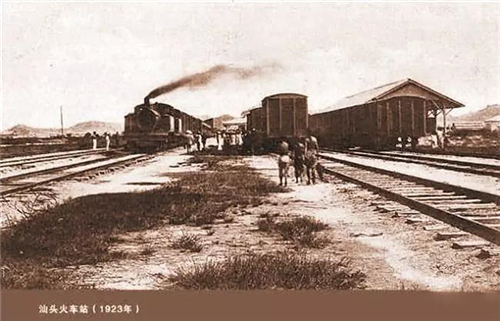
The picture shows the Shantou railway station of the Chaoshan Railway (1923). (Image from the Internet)
At that time, the Chaoshan Railway was an important part of the red transport of the Communist Party of China (CPC), which constantly transported salt, cloth, medicines, as well as electrical appliances, printing and ordnance to the Central Soviet Area, and at the same time, it was also tasked with handing over to the Central Committee of the CPC gold, silver and banknotes seized by the Central Soviet Area in the course of the struggle, and it had a very important historical position. During the Revolutionary period, when the White Terror enveloped cities and towns all over the country and the Chinese Revolution was at a low ebb, under the careful organisation and arrangement of the Shantou Transportation Station, countless revolutionary forefathers, including Zhou Enlai and Deng Xiaoping, arrived in Shantou from Shanghai and Hong Kong by ships through the Central Red Secret Transportation Line on many occasions, and then took the Chaoshan Railway to go to the Jiangxi and other Revolutionary Soviet Areas in a roundabout way, and the Chaoshan Railway has thus painted a colourful chapter in the history of the Chinese Revolution.
Unfortunately, in 1939, in order to resist the attack of the Japanese invaders, the Chaoshan military and civilians dismantled all the bridges along the Chaoshan Railway. After the fall of Chaoshan, the invading army snatched the remaining tracks and railway equipments and other materials of the whole railway line to Japan one after another. Thus, China's first private railway, after thirty-three years of dismal operation, was finally destroyed by the Japanese invaders. With the Chaoshan Railway becoming history, those old sites and witnesses related to the railway are mostly lost in the river of history.
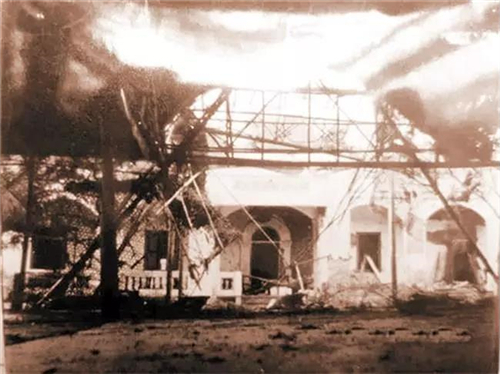
The picture shows the railway station on fire after being bombed by Japanese aircraft. (Photo from the Internet)
Fortunately, since the South Guangdong Ancient Post Road revitalisation Initiative was launched, it has focused on the in-depth discovery of the direction and ruins of the Central Red Secret Traffic Route, and the professional volunteers of the "Three Divisions" of Guangdong have responded positively, and have discovered a number of stops or points of contact of the Central Red Secret Traffic Route in Shantou and other places, so that the route from Shanghai to Shantou, Hong Kong and then on to the Central Soviet Union gradually surfaced. A line through Shanghai to Shantou, Hong Kong and then to the Central Soviet Zone gradually surfaced, and the Chaoshan Railway also shook off the dust of history and came back into people's eyes. The discovery of the former site of the General Affairs Department of the Chaoshan Railway Company is one of the important results of this work.
The discovery of this relic is still a bit of a dramatic event. It has been more than 80 years since the disappearance of the Chaoshan Railway, and those who have witnessed that part of the history would be nearly 100 years old if they were still alive, and their memory is quite limited. In addition, due to various factors, the data of the Chaoshan Railway is not well preserved, and the historical photos available on the internet are almost all left by the Japanese construction side of the Chaoshan Railway at that time, while the written records are almost non-existent. Therefore, it is really a difficult task to find the ruins and remains related to the Chaoshan Railway.
At that time, Mr A Rui, who is also a professional volunteer of the "Three Divisions", and I were both very interested in the history of the Chaoshan Railway, and in April 2019, I published an article titled "Talking about the Historical "Chaoshan Railway"" on the website of the South China Historical Trail. In April 2019, I published an article titled "Talking about the Historical "Chaoshan Railway"" on the South China Historical Trail website, in which I had already paid attention to the content of the Chaoshan Railway remains, and Mr Ary was also deeply interested in every blade of grass, every tree, every mountain and every water of Chaoshan, so we hit it off immediately, and then we started the collection of relevant information and excavation of the ruins and remains of the site.
At the beginning, we, together with other volunteers, made many visits to Umbu, Fuyang and other places, but unfortunately, we returned to no avail. In the late spring of 2019, when Mr Ah Shui came to Shantou again on official business, we met up and went to see the Shantou Small Park under restoration. When we passed by Wuqiao area, we chatted about the place where the Chaoshan Railway was launched, so we got off the bus on a whim to check it out. When we came to the entrance of the fire station, we happened to find a small, dilapidated building behind a big tree on the left side of the gate. This building has three stories high, the degree of damage has been very serious, the doors and windows of the east is missing a piece of the west is missing a piece of the east, in the wind shaking, the small building roughly see the overall appearance, only the top of the dense tree branches near the cover some of the grey lacquer in the green foliage in the background while even more show the age of the old. I couldn't help but think that this building should be very old. But Mr Arry, who studied architecture, stared at the eagle-like decorations on top of the building as if he had discovered a new continent, and slowly said, "There is a story here, there must be a story here, and it may be a story related to the Chaoshan Railway. I would have liked to go closer to explore the place, but as it is a dangerous building area, we are not allowed to enter it freely, so we just took some photos from the periphery and left.
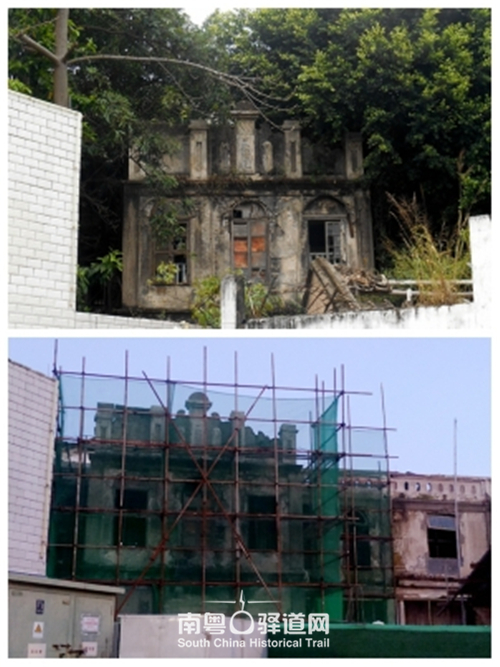
I did not take this matter very seriously, but I did not expect to receive a message from Mr Ah Shui a few days later. He told me excitedly that he had looked up the information and could finally confirm that the small building we found was the Shantou Station of the Chaoshan Railway in those days, which served as a ticket office, a warehouse and a dormitory for the railway staff! When I heard this news, I was simply too excited to speak. Before this, even if we looked up more information and visited more places, the conclusion we got was so frustrating: the 40-kilometre-long Chaoshan Railway is now only a physical legacy of the Yixi Station in Chaozhou. Now, we have found the site of the former Chaoshan Railway General Office in Shantou, on Wuqiao Island, where the Chaoshan Railway started, and the face of the Chaoshan Railway has finally become clearer.
Once upon a time, the Chaoshan Railway, as the first private railway in Chinese history, broke the illusion of European and American powers wanting to monopolise China's railway transport network, covering the trade of goods as well as the demand of passengers in the Greater Chaoshan area, the Hakka area, and as far as Fujian and Jiangxi, becoming a major artery pulling up the economy along the south-east coast of China. Nowadays, in the giant wheel of historical advancement, the cultural contexts and usage scenarios contained in the Chaoshan Railway have gradually disappeared, leaving only some historical fragments that vaguely reflect the glory of the time. As an important part of the central red secret transport line and a witness to the history of Chaoshan, the preservation and utilisation of the Chaoshan Railway's historical relics is an urgent task.
In October 2020, Shantou City and Jinping District authorities introduced the "Chaoshan Railway Company General Affairs Department Warehouse Site Project", which plans to demolish some of the surrounding buildings while repairing and consolidating the old building, in order to present the best viewing surface of the old railway station; and to build a public park of the type of Railway Memorial Plaza, which will be used for leisure and play, and will be able to better transmit the memory of the Red Revolution. A public park of the type of railway memorial square will be constructed, which will allow the public to have leisure and play, and at the same time better transmit the memory of the red revolution.
Meanwhile, the revitalisation of the Central Red Line of Communication has also achieved a series of results. The former site of the red traffic station located at No. 97 Hai Ping Road in Shantou City was successfully revitalised into the Shantou Traffic Station Exhibition Hall, which was listed as one of the eighth batch of national key cultural relics protection units in 2019, and with precious physical objects and historical materials, it tells visitors about the thrilling underground work of the year.2021 In order to celebrate the 100th anniversary of the founding of the Party, the Shantou Fusion Media Group meticulously planned and filmed the series of feature films "Red Traffic Line" to present a series of films on the traffic line, including "Red Traffic Line", which is a series of films about the red traffic line. Traffic Line", the moving stories happened on the traffic line on the screen, revisit the glorious history of the party leading the people to carry out the great struggle. It is understood that the 5th Cultural Creativity Competition of the Southern Guangdong Ancient Post Road will also come into Chaoshan, focusing on the Central Red Traffic Route (Guangdong section), and striving to launch a number of excellent cultural and creative products to deepen people's understanding of the Red Traffic Route.
In addition, Shantou is building two cultural tourism routes, namely, the "Zuo Lian" tour in Southern Guangdong and the "Central Red Secret Traffic Route" tour. They are cultural routes with artistic value and red memories built on the Guangdong Wanli Bidao and the South Guangdong Ancient Post Road with Guangdong characteristics. From Shantou Xidi Park to Meizhou Sanheba Battle Memorial Hall, the planned route is about 150 kilometres long, along which many historical and cultural relics related to the Left League such as the former residence of Chen Bo'er, the former residence of Hong Lingfei, the former residence of Dai Pingwan, and other natural and historical and cultural nodes such as the ancient fortress of Longhu and the Fenghuang Mountain will be linked through the greenway, so that it creates a route which can be travelled, appreciated, viewed and sensed, It will create a red cultural tour route that can be travelled, appreciated, viewed and felt.
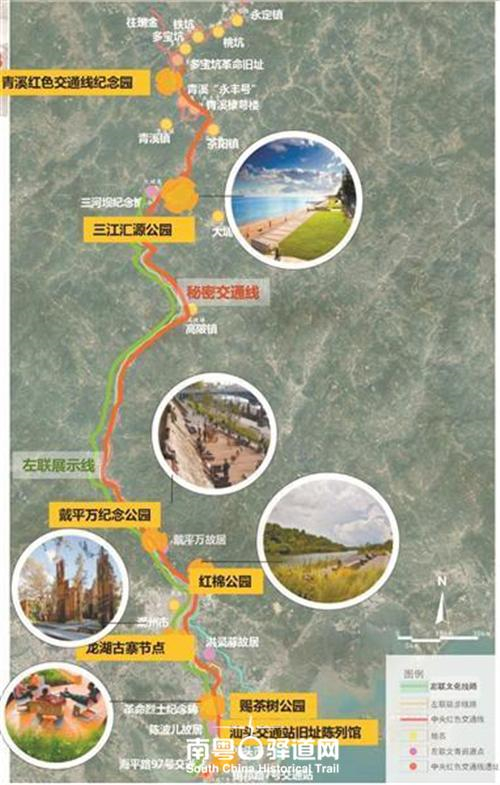
The picture shows the planned routes of the "Left Alliance" Red Tour and the Secret Line of Communication Tour in Southern Guangdong.
It is worth mentioning that, after the azalea bloomed in the educational and historical study base in northern Guangdong and southern China, the professional volunteers of Guangdong Province's "Three Teachers" once again invested in the revitalisation of the Central Red Transportation Line with a high sense of historical responsibility, followed up on the progress of the various projects in real time and provided professional guidance, and devoted themselves to the recreation of the old stagecoach routes of southern Guangdong in the old days of the hidden fronts and the bloodthirsty years.
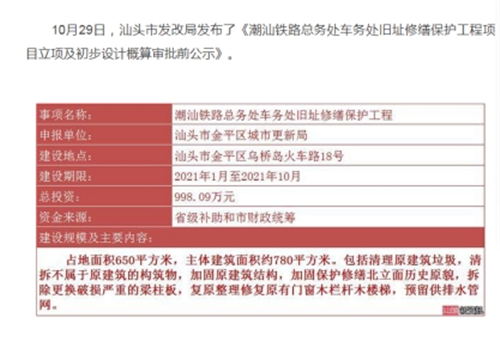
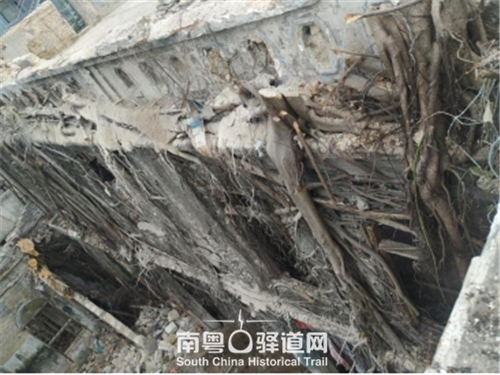
Today, all the work is being carried out in an orderly manner, when passing by here, you can clearly see the building body and the surrounding demolition, reinforcement, protection and other traces of construction.
(All rights reserved. Please indicate that it is from South China Historical trail website.)
责任编辑:周文娟